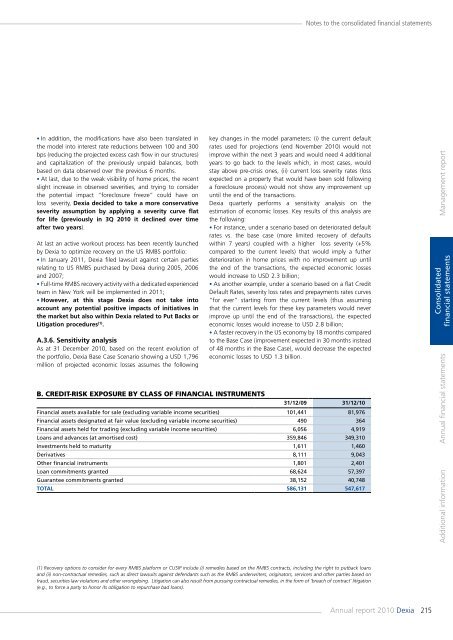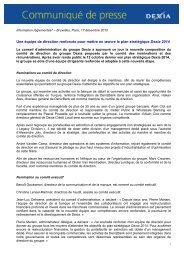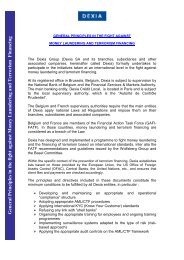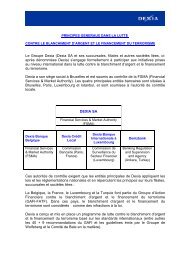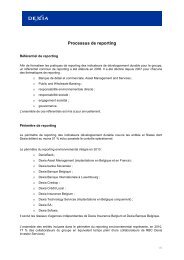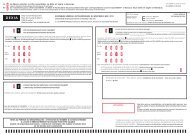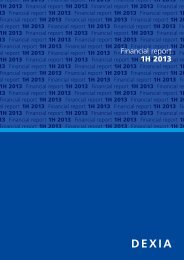Annual report 2010 - Dexia.com
Annual report 2010 - Dexia.com
Annual report 2010 - Dexia.com
- No tags were found...
Create successful ePaper yourself
Turn your PDF publications into a flip-book with our unique Google optimized e-Paper software.
Notes to the consolidated financial statements• In addition, the modifications have also been translated inthe model into interest rate reductions between 100 and 300bps (reducing the projected excess cash flow in our structures)and capitalization of the previously unpaid balances, bothbased on data observed over the previous 6 months.• At last, due to the weak visibility of home prices, the recentslight increase in observed severities, and trying to considerthe potential impact “foreclosure freeze” could have onloss severity, <strong>Dexia</strong> decided to take a more conservativeseverity assumption by applying a severity curve flatfor life (previously in 3Q <strong>2010</strong> it declined over timeafter two years).At last an active workout process has been recently launchedby <strong>Dexia</strong> to optimize recovery on the US RMBS portfolio:• In January 2011, <strong>Dexia</strong> filed lawsuit against certain partiesrelating to US RMBS purchased by <strong>Dexia</strong> during 2005, 2006and 2007;• Full-time RMBS recovery activity with a dedicated experiencedteam in New York will be implemented in 2011;• However, at this stage <strong>Dexia</strong> does not take intoaccount any potential positive impacts of initiatives inthe market but also within <strong>Dexia</strong> related to Put Backs orLitigation procedures (1) .A.3.6. Sensitivity analysisAs at 31 December <strong>2010</strong>, based on the recent evolution ofthe portfolio, <strong>Dexia</strong> Base Case Scenario showing a USD 1,796million of projected economic losses assumes the followingkey changes in the model parameters: (i) the current defaultrates used for projections (end November <strong>2010</strong>) would notimprove within the next 3 years and would need 4 additionalyears to go back to the levels which, in most cases, wouldstay above pre-crisis ones, (ii) current loss severity rates (lossexpected on a property that would have been sold followinga foreclosure process) would not show any improvement upuntil the end of the transactions.<strong>Dexia</strong> quarterly performs a sensitivity analysis on theestimation of economic losses. Key results of this analysis arethe following:• For instance, under a scenario based on deteriorated defaultrates vs. the base case (more limited recovery of defaultswithin 7 years) coupled with a higher loss severity (+5%<strong>com</strong>pared to the current levels) that would imply a futherdeterioration in home prices with no improvement up untilthe end of the transactions, the expected economic losseswould increase to USD 2.3 billion;• As another example, under a scenario based on a flat CreditDefault Rates, severity loss rates and prepayments rates curves“for ever” starting from the current levels (thus assumingthat the current levels for these key parameters would neverimprove up until the end of the transactions), the expectedeconomic losses would increase to USD 2.8 billion;• A faster recovery in the US economy by 18 months <strong>com</strong>paredto the Base Case (improvement expected in 30 months insteadof 48 months in the Base Case), would decrease the expectedeconomic losses to USD 1.3 billion.B. Credit-risk exposure by class of financial instruments31/12/09 31/12/10Financial assets available for sale (excluding variable in<strong>com</strong>e securities) 101,441 81,976Financial assets designated at fair value (excluding variable in<strong>com</strong>e securities) 490 364Financial assets held for trading (excluding variable in<strong>com</strong>e securities) 6,056 4,919Loans and advances (at amortised cost) 359,846 349,310Investments held to maturity 1,611 1,460Derivatives 8,111 9,043Other financial instruments 1,801 2,401Loan <strong>com</strong>mitments granted 68,624 57,397Guarantee <strong>com</strong>mitments granted 38,152 40,748Total 586,131 547,617Management <strong>report</strong>Consolidatedfinancial statementsAdditional information <strong>Annual</strong> financial statements(1) Recovery options to consider for every RMBS platform or CUSIP include (i) remedies based on the RMBS contracts, including the right to putback loansand (ii) non-contractual remedies, such as direct lawsuits against defendants such as the RMBS underwriters, originators, servicers and other parties based onfraud, securities law violations and other wrongdoing. Litigation can also result from pursuing contractual remedies, in the form of ‘breach of contract’ litigation(e.g., to force a party to honor its obligation to repurchase bad loans).<strong>Annual</strong> <strong>report</strong> <strong>2010</strong> <strong>Dexia</strong>215


